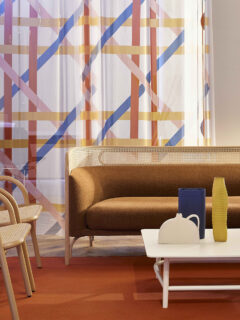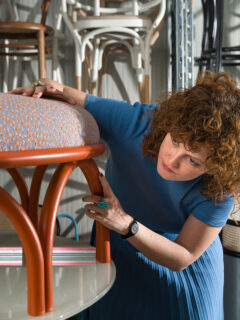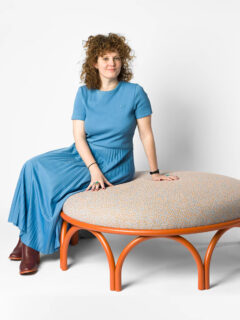Interview | Serena Confalonieri
- The installation “A woven story”, designed by you for Gebruder Thonet Vienna at the Salvioni Milano Durini showroom, is conceived as a tribute to Vienna straw, one of the great symbols of the Austrian brand. What is the story behind this installation? And what does working with such a particular material entail?
The objective of the set-up was to showcase the historical continuity of the brand; therefore, the starting point of the concept was precisely the Vienna straw, which has always identified the production of Gebrüder Thonet Vienna. The setup is in fact designed as a real stage, where the plot is present in every scenography: in the pattern of the curtains that surround the space, in the backdrops placed behind each product and on many of the products themselves.
- It certainly isn’t every day that you get to work with a brand like GTV which has almost two centuries of history. How does a designer approach such an important heritage? And what are your favorites among the great classics of the brand?
When approaching a particularly iconic brand it is certainly essential to respect its identity. At the same time, Gebrüder Thonet Vienna has been able over the years to open up to a contemporary, sometimes even bold, design, while maintaining some historical elements, such as bent wood and Vienna straw. This allowed me – both in the setup and in the creation of the Arcadia ottoman that I designed for the company – to play with these elements and with the heritage of the brand in an extremely creative way. Speaking of classic pieces, among my favorites there are certainly the No. 18 and No. 14 chairs, I think they are of truly timeless beauty.
- For GTV you also designed a product, the Arcadia pouf, which is among the great protagonists of the installation. Can you tell us about its genesis and how the collaboration was born?
The company’s request in that case was to use another of its iconic elements: curved wood. Arcadia, in fact, is characterized by a play of arches which, repeating one next to the other, become a structural basis and at the same time an aesthetic element. The design is inspired by the arches and colonnades of neoclassical gardens, while the generous dimensions invite sharing: it is therefore also suitable for the contract environment.
- Color always plays a very important role in your creations. Where do you draw inspiration from for this distinctive color palette of yours?
I like to think that color is the most sentimental part of my projects, because it immediately reaches the eyes, transmitting an emotion. It is also for this reason that the colors in my palettes are always cheerful, lively.
- Who are the big names in the Italian and international design tradition that you feel are closest to your style and that you look up to as role models?
Here in Italy, Gio Ponti’s versatility influenced me greatly. I am also very attached to the aesthetics of Josef Hoffmann, for the push towards geometric abstraction and the style of Luis Barragan, for the references to nature and the use of essential colors and shapes.
- What are your plans for the future? Do you intend to increasingly extend your work to interior design, as already happens for many designers of your generation, or do you intend to remain focused above all on the design of products and installations?
I have always worked in very different fields: products, self-productions, installations, interiors, urban art, graphics. I like to range across different scales and worlds and I don’t like to be channeled into a too specific figure. I find it very stimulating to interpret the small object as well as a square or, to use a famous slogan, we can say “from the spoon to the city”!














